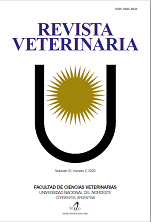Interaction of an domestic dog with an unknown person in a novel environment
DOI:
https://doi.org/10.30972/vet.3124743Keywords:
canine, environment, adaptation, answers, interaction human-animal, sensorial and behavioral homeostasisAbstract
The domestic dog is able to adapt to new environments by changing their behavior depending on the context. In this process, activation of the autonomic nervous system and the hypothalamic-pituitary-adrenal axis under the control of consciousness involved. The aim of this study was to evaluate the influence of the external environment (clinical practice) on the interaction of dog with an unknown man. This work was performed in a private clinical practice, for it were randomized 8 adults dogs, of both genders and different races who attended the clinic. Of these, only half knew the environment (population A), the other half unknown (population B). All were applied a communication test against an unknown person. They were shot 4 minutes with camcorder from an adjacent room of 9 m2 window. Then focal and continuous observation of each animal was performed, recording the following variables: eye contact (frequency), latency approach and stay near the unknown (in seconds). For statistical analysis t-test was applied to check the distribution of the means of the two populations (A and B). This test showed no significant difference (p ≥ 0.05) behavioral responses between the two groups (known versus unknown environment). However, there was a trend of more frequent eye contact with the person who did not know the environment (mean = 6.00), compared with those who did know him (mean = 1.75) (p = 0.09), probably trying to start inter-specific communication faster with the human in a novel environment. When dogs attend the clinic as patients consulting for the first time, the office environment is totally unknown: smells, sights, other dogs and people. In this unfamiliar environment, it is with human beings with whom he develops eye contact and touch to keep your sensory homeostasis, and thus achieve a balance back into behavioral homeostasis.Downloads
References
Barrera G, Jakovcevic A, Elgier AM, Mustaca A, Bentosela M. 2010. Responses of shelter and pet dogs to an unknown human. J Vet Behav Clin Appl & Result 5: 339-344.
Barrera G, Giamal Y, Mustaca A, Bentosela M. 2012. Relación entre el tipo de alojamiento y las respuestas de mirada, sociabilidad y miedo-apaciguamiento en perros. Suma Psicol 19: 7-18.
Coppola CL, Grandin T, Mark ER. 2006. Human interaction and cortisol: can human contact reduce stress for shelter dogs? Physiol Behav 87: 537-541
Dawson LC, Dewey CE, Stone EA, Guerin MT, Niel L. 2018. Evolution of a canine and feline behavioral welfare assessment tool for use in companion animal veterinary practice. Appl Anim Behav Sci 201: 67-76.
Györi B, Gacsi M, Miklosi A. 2010. Friend or foe: context dependent sensitivity to human behavior in dogs. Appl Anim Behav Sci 128: 69-77.
Hennessy MB. 2013. Using hypothalamic-pituitary-adrenal measures for assessing and reducing the stress of dogs in shelters: review. Appl Anim Behav Sci 149: 1-12.
Jakovcevic A, Mustaca A, Bentosela M. 2012. Do more sociable dogs gaze longer to the human face than less sociable ones? Behav Process 90: 217-222.
Kerepesi A, Dókaa A, Miklósi A. 2015. Dogs and their human companions: The effect of familiarity on dog-human interactions. Behav Proc 110: 27-36.
Kuhne F, Hößler JC, Struwe R. 2014. Emotions in dogs being petted by a familiar or unfamiliar person: Validating behavioral indicators of emotional states using heart rate variability. Appl Anim Behav Sci 161: 113-120.
Kuhne F. 2016. Behavioral responses of dogs to dog-human social conflict situations. Appl Anim Behav Sci 182: 38-43.
Prato P, Nicotra V, Pelosi A, Valsecchi P. 2018. Pet dogs`behavior when the owner and an unfamiliar person attend to a faux rival. Plos one 1-17.
Protopopova A. 2016. Effects of sheltering on physiology, immune function, behavior, and the welfare of dog. Physiol & Behav 159: 93-103.
Roth LS, Jensen P. 2015. Assessing companion dog behavior in a social setting. J Vet Behav 10: 315-323.
Shin YJ, Shin NS. 2017. Relationship between sociability toward humans and physiological stress in dogs. J Vet Med Sci 79: 1278-1283.
Downloads
Published
How to Cite
Issue
Section
License
Revista Veterinaria (Rev. Vet.) maintains a commitment to the policies of Open Access to scientific information, as it considers that both scientific publications as well as research investigations funded by public resources should circulate freely without restrictions. Revista Veterinaria (Rev. Vet.) ratifies the Open Access model in which scientific publications are made freely available at no cost online.










.jpg)
.jpg)



